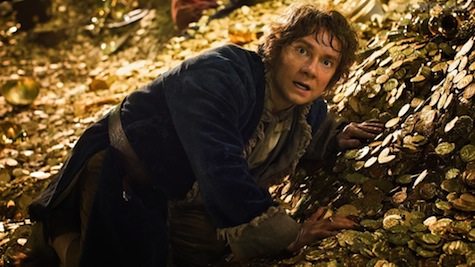Welcome back to the chapter-by-chapter reread of The Hobbit, which I’ve reopened so we can talk about the movie The Hobbit: The Desolation of Smaug. As you may recall, I liked the first movie more than I expected, and was surprised at some of the ways it adapted events from the larger Middle-earth canon. After the jump, I’ll discuss how I felt about this movie and run through some comparisons with the books. As always, spoilers for the movies and everything Tolkien (The Hobbit, The Lord of the Rings, The Silmarillion, and various posthumous tidbits). You can catch up with the past reread posts at the Hobbit reread index and the LotR reread index.
This post turned out to be epically long, but it’s broken up into sections for ease of reference, so click the jump link and let’s talk!
General Comments
Unfortunately, I did not like this movie as much as the first. It shared the same tendency of the first movie to re-hash bits of the LotR movies, and then added re-hashing bits of the first Hobbit movie, so that it all started feeling kind of been-there-done-that. Add in too much orc-fighting, not enough Bilbo, and as the jump quote says, it starts feeling like butter that has been scraped over too much bread.
Let’s take the rest of this thematically.
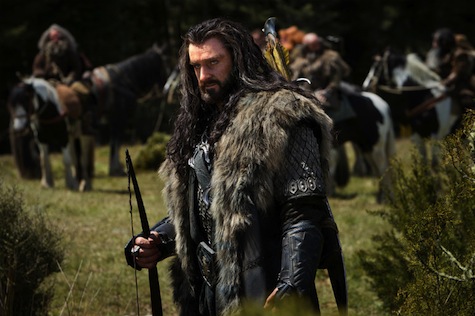
The Arkenstone, Thorin, and Bilbo
The movie starts with a Bree flashback, the conversation between Thorin and Gandalf that is in Appendix A, Part III (“Durin’s Folk”) of LotR. The very first thing in this scene is Peter Jackson repeating his Fellowship cameo, which is either cute or an ominous sign of things to come, depending on one’s mood. But the more significant revelation is that Thorin plans to burglarize the Lonely Mountain to get the Arkenstone, which is the MacGuffin that will unite the dwarf Houses and allow them to drive out Smaug. I actually like this change a lot, because it makes much more sense than the “1) sneak into mountain with lone burglar; 2) ???; 3) profit!” plan in the book. I’m not sure about making the Arkenstone the symbol of the right to rule when it also corrupts (in the movie, it’s the source of treasure-sickness generally, and in the book, it enchants those who see it with the desire for it), but that’s a relatively small quibble.
Speaking of Bilbo taking the Arkenstone, I think that’s definitely going to come next movie, when they’re exploring in Smaug’s absence, as in the book; it won’t be revealed in flashback that he picked it up while on the run from Smaug, before Thorin comes down into the Mountain, as I briefly thought it might be. That’s because Thorin’s action when he comes down, drawing steel on Bilbo just to ask whether he’d seen it, is going to be Bilbo’s motivation to pick it up and keep it secret.
Less of Thorin being an Epic Emo Hero of Epic Emo Heroicness this time, which was fine by me, though I did laugh out loud at the blatant visual shorthand when Thorin is silhouetted against the giant statue of his grandfather on the doorstep while Balin lectures him about the desire for treasure changing his personality just as it did his grandfather.
Beorn
I didn’t like the character design or the backstory. In the book, Beorn is “a huge man with a thick black beard and hair, and great bare arms and legs with knotted muscles” (Chapter 7, “Queer Lodgings”). I like that he’s fully human in appearance in his non-bear form, to make the contrast greater, and that his human appearance emphasizes his outsized personality. The movie’s version is not fully human in appearance and not very booming, which I didn’t think were necessary or interesting changes. Also, I didn’t like that the movie invented a “held prisoner by orcs, who killed all his kind” backstory to give him a reason to help the travelers, because it’s a long-standing gripe of mine: the movie-makers apparently don’t believe that people can do the right thing solely because they’re good people, so they have to invent self-interested motivations, however unlikely (see: Treebeard not knowing what Saruman had done to the forests).
However, I am glad that they skipped bringing the dwarves in two at a time, because dwarves as comic relief doesn’t work for me in these movies. The marvelous serving animals were also properly dropped, because not only are they tonally dissonant even without the new Beorn, but the dogs in particular would be very difficult to make convincing. (Or is it only me who finds it very disturbing to watch actual dogs walk on their hind legs?)
Mirkwood
This section of the movie streamlines the book considerably by entirely dropping the trip-into-Faerie element that we talked about in the Chapter 8 post, with all the amnesia-inducing streams and feasts just out of reach and so forth. To streamline things and reduce confusion, moving the source of the forest’s enchantments to the spiders (or, possibly, Sauron—evil things, anyway) makes sense, but I still kind of miss it.
There’s also less Action Hero Bilbo here than in the book when it comes to the spiders, which again makes sense—it helps make the dwarves more active and sympathetic and is probably more plausible—but again, I still kind of miss it, because I like Bilbo being awesome. (This also applies to the Barrels out of Bond sequence.) Instead, we get a rather disturbing movie-only sequence in which Bilbo kills a crab-thing in a frenzy after he perceives it to be a potential threat to his possession of the Ring. This makes this movie more consistent with LotR in two ways, first in terms of how influential and dangerous the Ring is, and second in giving Bilbo additional reasons to keep the Ring secret.
I like that Gandalf is sad to leave the company, which makes me feel more positively-inclined toward him than the book version. I love that the spiders talk in Wraith-o-vision; I think that’s a very clever way to get that element of the book into the movie, which doesn’t have talking animals.
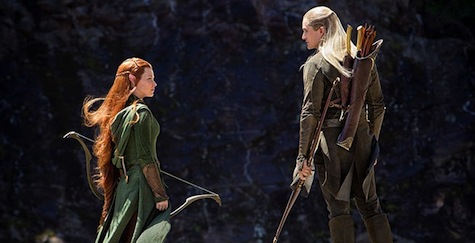
Thranduil, Tauriel, and Legolas
You may be surprised that Tauriel did not bother me! I sure was. But the unconvincing love triangle was downplayed, and I liked that she had a principled conflict with Thranduil and wanted to see more of the world and that she, you know, existed. (There are literally no female characters in the entirety of The Hobbit.) Unfortunately, she fell victim to the unnecessary revisiting of the LotR movies at the end, when she went all glow-y while healing Kili with athelas. This movie did not need a cheap Arwen knockoff. (Really, nothing needs a cheap Arwen knockoff.)
Thranduil didn’t work for me, though at least he didn’t work in a different way from Elrond. I wonder if the weird approaches taken with regard to the high-ranking male elves are because the movie-makers have issues with reconciling the characters’ textual grace and beauty with their concept of masculinity? The bit that was most out of left field was where Thranduil says he knows about the dangers of dragons and either reveals that the smooth skin of his cheek is an illusion and he’s horribly burned underneath, or uses an illusion to demonstrate his past injuries. (There’s nothing about him and dragons in The Hobbit, LotR, or The Silmarillion that I can find. Well, technically in The Hobbit he’s still Thingol (as discussed in comments to the Chapter 8 post), but I don’t think Thingol had anything significant to do with dragons either.) But on the whole his scenes just left me feeling, “That was weird,” rather than engaged with the story.
The bit about Tauriel being a mere sylvan elf briefly confused me because I’d forgotten that Thranduil is, like Elrond and Thingol, textually a High Elf (per the very start of Appendix B in LotR). And hey, the movie did the drunk elves after all! We doubted that it would go there when talking about the chapter.
My comment about Legolas is actually a comment about Orlando Bloom: I couldn’t figure out why Legolas looked weird until I remembered that the LotR movies were a decade ago and Bloom is still of an age where the shape of his face broadens over that amount of time. The hairstyle he’s forced to use doesn’t help this any. (In contrast, Martin Freeman looks younger than his usual self as Bilbo, and while part of that has to be makeup, I suspect the curly wig lets his face look narrower.)
Finally, this goes here for lack of a better place to put it: Barrels out of Bond was the escape from the goblins under the Misty Mountains, second verse, same as the first.
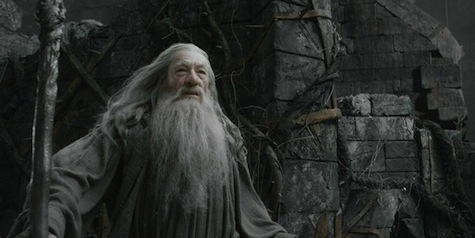
Gandalf and Dol Guldur
There wasn’t much to this plot thread, but I still wasn’t very impressed.
Since I looked this up for my own benefit, here’s what we know about the Necromancer and Dol Guldur in the books. Per Appendix B in LotR, around 1100 in the Third Age, “The Wise (the Istari and the chief Eldar) discover that an evil power has made a stronghold at Dol Guldur. It is thought to be one of the Nazgûl.” In 2063, Gandalf goes to Dol Guldur to investigate the Wise’s fears that it’s actually Sauron, but his investigation is inconclusive because Sauron retreats to the East and doesn’t come back for four hundred years.
About three hundred years after Sauron returns to Dol Guldur, Smaug drives the Dwarves out of Erebor. This kicks off the war between the dwarves and the orcs in Moria and eventually leads to Thorin’s father, Thráin, being imprisoned in Dol Guldur for five years. In 2850, Gandalf enters Dol Guldur for the second time, confirms that the Necromancer is Sauron, and receives the map and key from Thráin before Thráin dies. But Gandalf cannot convince the White Council to attack (Saruman blocks him for nefarious reasons), which is where things stand ninety years later when The Hobbit begins.
And, because I looked this up too, the Nazgûl: before Gandalf’s first trip to Dol Guldur, Angmar is destroyed and the Witch-king flees from Glorfindel, who tells Eärnur, “Do not pursue him! He will not return to this land. Far off yet is his doom, and not by the hand of man will he fall.” The Witch-king heads to Mordor, gathers the other Nazgûl, and eventually takes Minas Ithil. Eärnur becomes King of Gondor, and the Witch-king successfully challenges him to single combat by taunting him with his failure to pursue back when Angmar was destroyed . . . with the end result that the Stewards end up ruling Gondor. (This is out of Appendix A to LotR, if you’re looking to read it for yourself.)
I don’t mind compressing the timeline about Gandalf’s discovery that the Necromancer is actually Sauron. That’s a standard movie adaptation technique, and especially useful given Tolkien’s timescale. I do mind the change to the Witch-king, for two reasons. First, “not by the hand of man” exists in the movies (go Éowyn!), so as I said about the first movie, it’s hard to reconcile that with the “OMG did he rise from the grave??!!” in these movies. Second, I was not impressed by the way this movie implemented the tombs. When Gandalf first went sliding down the tunnel, I whispered to Chad, “The episode was badly written!” (Galaxy Quest, of course), because the entire physical setup felt like it was only there to create artificial peril for the characters.
Finally, I wasn’t particularly moved by Gandalf attempting to escape Dol Guldur. The effect of the humanoid-figure outlined in fire oscillating and then resolving into the Eye failed to work for me. And oh look, here’s Gandalf imprisoned in a high place again, just like in the LotR movies, look, look, a parallel! (In the books Thráin’s thrown into Dol Guldur’s pits, which is presumably where Gandalf finds him.)
I did like that Radagast didn’t come back, however. I’m always glad when people promise not to come back for good reasons and then stick to it. (It’s probably my favorite thing about the first Bourne movie, which I like a lot.)
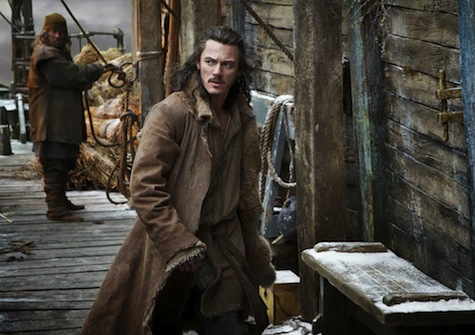
Bard and Laketown
I appreciate the attempt to give Bard some characterization. Really, I do. I just didn’t find it very interesting characterization. Admittedly it started right after the interminable Barrels out of Bond sequence when I was not in the best of moods, and his resemblance to Orlando Bloom-as-Will Turner was definitely distracting. How did this work for you all?
(In case you were wondering too, Bard’s children are not, actually, Peter Jackson and Fran Walsh’s adorable moppets Billy and Katie, who had cameos in all three LotR movies.)
The prophecy that Bard quotes isn’t in the book, by the way. There’s a song about the King under the Mountain’s return, which does contain the line “The lakes shall shine and burn” (Chapter 10, “A Warm Welcome”), but in context that’s a good thing, not the portent of doom that Bard makes it.
And splitting up the dwarves, okay, I can see that this helps differentiate them and thus may make us care more when Fili and Kili die (not to sound bloodthirsty, but they’d better still die), but between the athelas re-tread I already mentioned and yet more orc killing, this section kind of dragged for me.
As for the other people in Lake-town proper, Stephen Fry is of course fun, but the Master’s assistant Alfred, a movie-only character, feels too much like a Wormtongue re-tread. (He also looked hunchbacked to me, which, can we please stop with physical disability = evil?) However, I was genuinely delighted to see people with brown and black skin in the crowds, being just ordinary people and not enemies on a battlefield. And it makes sense, too, since Lake-town was once a major trade center.
Changing Bard’s bow to a big-ass fixed mechanism is something I don’t really care about; if it makes it easier for people to accept Smaug’s death, fine, though apparently the book’s version is entirely plausible. I do like the change that Girion’s prior attempts to shoot Smaug knocked a scale loose, though; when I was rereading chapter 12, I didn’t buy that Smaug would overlook the bare spot in his treasure-armor. This also neatly side-steps the talking-thrush problem.
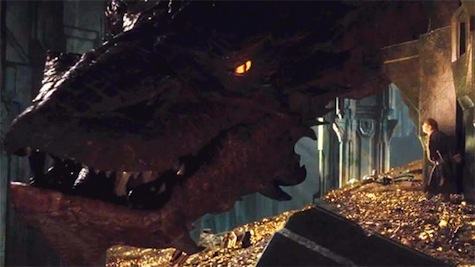
The Lonely Mountain and Smaug
The reveal of the keyhole. Though I had to go back and check, the first movie quotes the text of the book verbatim when it comes to the moon-letters on the map: “Stand by the grey stone when the thrush knocks, and the setting sun with the last light of Durin’s Day will shine upon the key-hole” (Chapter 3, “A Short Rest,” emphasis added). Durin’s Day, as we hashed out at some length in the Chapter 3 post and comments, is the first time the waxing crescent moon and the Sun are seen together in the sky during the last moon of Autumn. The phase of the moon we saw in this movie looked more than a bit past new, but more importantly, the text of the map cannot be made consistent with Bilbo’s discovery that the moon’s light reveals the keyhole.
More, this change seems to have been made just to create drama that I found artificial even during the movie, before I checked whether it was consistent. I didn’t believe that the dwarves would just give up like that and immediately leave (walking down in the dark, really?), and then of course Bilbo has to almost knock the key over the edge. (However, Chad tells me that he thought we were in for five minutes of Bilbo hanging by his toes over the precipitous drop trying to get the key, so I guess I should be grateful for small favors.)
Enough of that. Our title characters, together at last!
Smaug is, of course, great. His character design is right in WETA’s wheelhouse (no feathers or fur). I do not worship at the altar of Cumberbatch, but I thought he did a terrific job as Smaug’s voice, and it was really nice to get Bilbo front and center, because Freeman’s portrayal is the best thing about these movies for me by a long shot. Their conversations weren’t quite as good as Riddles in the Dark for me, but they were still very enjoyable.
Unsurprisingly though sadly, however, I do have some quibbles about Smaug. Look, I understand that having gone to the trouble of designing a kick-ass dragon and getting a rising star to voice him, you want to get more out of the character than two conversations and a death over Lake-town, without the dwarves ever even getting a shot in. So I’m actually fine with the idea of an extended chase-and-fight sequence inside the Mountain. But the way it happened occasionally detracted from Smaug’s scariness, because some of those episodes did not feel either like genuinely plausible escapes or like Smaug was deliberately playing with them. The worst was when Smaug slowly goes right over the bridge where Thorin, Bilbo, and Balin (if I remember my characters right) are standing and doesn’t notice they’re there, but there are a number of other escapes that felt hard to buy considering the characters are up against a literal fire-breathing dragon. So that dropped the tension for me in unfortunate ways. Plus, the sequence seemed to go on rather a long time, and the symbolism of the molten gold dwarf king seeming to defeat Smaug but actually just enraging him was a smidge obvious for my tastes.
However, that cliffhanger is ferocious. I approve.
What’s Next
Apparently both Azog and Bolg are surviving into the third movie! Will they both be at the Battle of the Five Armies? Will Dáin still get to kill Azog while Beorn kills Bolg, or is Thorin going to get one of those victories? Will Azog be at Dol Guldur instead? As I said last time, I’ve always liked Dáin in the books, based on the little we get, and I’d like to see him get a moment of glory.
One necessary change: Gandalf can’t stop the brewing battle between the dwarves on one hand and the Elves and the Lake-town people on the other, just by announcing that orcs are coming, because multiple characters know that orcs are chasing Thorin and have been to Lake-town. I expect the elves and humans and the dwarves will still come to the verge of blows somehow, though, because that’s just how these movies roll. (Presumably Fili, Kili, and whoever-else stayed with them will make it to the Mountain somehow, perhaps with derring-do on the part of Tauriel?)
Obviously we’ll have the battle at Dol Guldur, about which there is essentially nothing in the books. The Hobbit says only that the White Council “had at last driven the Necromancer from his dark hold in the south of Mirkwood” (Chapter 19, “The Last Stage”), and The Silmarillion adds merely that “the Dark Lord had foreseen” the attack, and “Therefore his flight was but a feint, and he soon returned, and ere the Wise could prevent him he re-entered his kingdom in Mordor and reared once again the dark towers of Barad-dûr” (“Of the Rings of Power and the Third Age”). Which we knew anyway from The Lord of the Rings, of course. Since that’s a less-than-definitive victory, it’ll be interesting to see how it’s framed against Smaug’s death, which in the book is also surprisingly anti-climactic. The order of events and the pacing is going to be tricky.
What about you all? What are you particularly looking forward to in the next movie? What did you think worked well or not-so-well in this one? I have gone on for such a long time here, let’s hear what you all thought!
Kate Nepveu was born in South Korea and grew up in New England. She now lives in upstate New York where she is practicing law, raising a family, and (in her copious free time) writing at Dreamwidth and her booklog.










